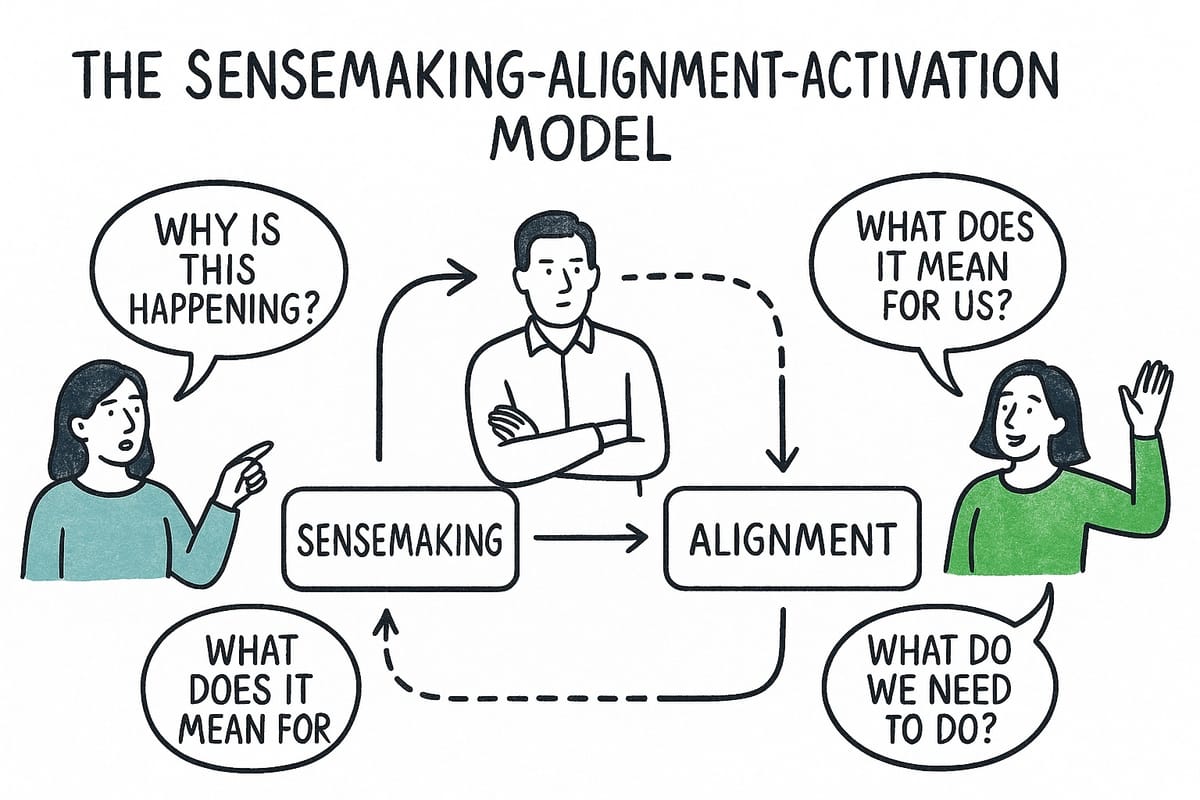The Sensemaking–Alignment–Activation Model: What Change Communication Is Really For
Most people treat change comms like a messaging exercise. But it’s much more than that. This model helps leaders and communicators drive real change by making sense of what’s happening, building alignment, and activating behaviour at every level.

Too often, change communications is treated like the final step in a change process. The tidy slide deck. The all-staff email. The launch video with music and a tagline. But that’s not communication. That’s announcement.
Real change communication starts much earlier. It helps people make sense of what’s happening, aligns them around a shared direction, and activates the behaviours that bring the change to life.
At Rewired Work, we use a simple but transformational model to reframe the role of communication in change: Sensemaking. Alignment. Activation. These are the three jobs of communication when change is real, messy, and already in motion.
Sensemaking: Help People Understand What’s Happening
Change always creates uncertainty. People start asking: Why is this happening? What does it mean? What are they not telling us?
The role of communication in this phase is to make sense of the change. That means:
- Providing context, not just content
- Showing your working—how decisions were made, what options were considered, why this path was chosen
- Surfacing tensions or trade-offs and being honest about complexity
Sensemaking isn’t about having all the answers. It’s about building trust by sharing what you know, when you know it, and helping people connect the dots. It’s leadership through communication.
Alignment: Create Coherence Across the Organisation
Once people begin to understand the why, they want to know what this means for them—and whether the organisation actually knows where it’s going.
This is where alignment comes in. Alignment is about coherence across:
- Leadership messages and behaviours
- Team priorities and communication
- Strategy, operations, and language
When leaders say different things—or worse, act in ways that contradict the message—trust fractures. When teams receive mixed messages about what’s important, confusion spreads. Alignment isn’t just about what’s said. It’s about ensuring the story, the behaviours, and the decisions are pulling in the same direction.
Good communication builds and sustains that coherence. It becomes the connective tissue between people, purpose, and progress.
Activation: Turn Understanding Into Momentum
Finally, communication has to help people do something. That might mean letting go of an old way of working, adopting a new system, testing a different process, or trying out a new mindset.
Whatever it is, the change only becomes real when people start behaving differently. And that’s where communication becomes a lever—not just a channel.
Activation involves:
- Signalling the behaviours you want to see
- Reinforcing action with feedback, recognition, and clarity
- Creating a rhythm of updates and check-ins that build confidence over time
Too many change programmes stop at understanding. But if there’s no behaviour change, there’s no change. Activation closes the gap.
How to Use This Model in Practice
Most organisations jump straight to messaging without asking:
- Have we helped people make sense of this yet?
- Is there real alignment behind the curtain?
- What are we doing to activate behaviour at scale?
Using this model gives you a way to sequence and structure your change comms properly. It helps you spot what’s missing—and it gives your communication team a much stronger seat at the strategy table.
If you’re a leader, this model keeps you accountable for clarity.
If you’re a communicator, it puts you at the heart of transformation.
If you’re a project or change lead, it helps you see where to focus next.
You might also want to read:
- How to Communicate Change
- The Sensemaking–Alignment–Activation Model
- Sensemaking in Change Communication
- Creating True Alignment for Organisational Change
- Activating Behaviour During Change
Need to Sense-Check Your Change Comms?
Start with the Sound & Signal Review. It’s our flagship diagnostic tool designed to uncover what’s working, what’s missing, and how to shift your communication from broadcast to behaviour change.
Or if you need to get leadership aligned and unstuck, the Rapid Action Accelerator is built to turn inertia into action—fast.
